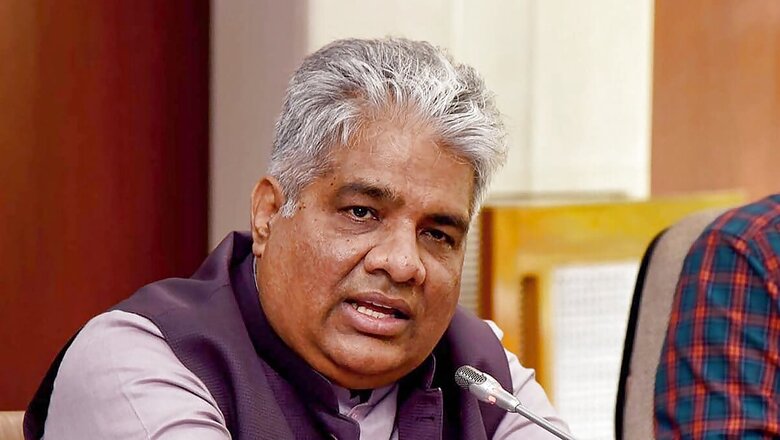
views
As floods in low-lying areas of Delhi and parts of Himachal Pradesh and Uttarakhand continue to be a cause of concern, they also raise several questions on environment and global warning. Can this devastation be avoided or prevented? Does the Centre have a plan? How can Earth be saved?
In an exclusive interview to News18, Environment Minister Bhupendra Yadav spoke about the effects of construction, roadmap for hilly areas and the government’s ambitious Project Cheetah. Edited excerpts:
Each time massive floods or rains take place, questions are raised over reckless construction. Any suggestion you would give?
There is no established study for India providing a quantified attribution of development/construction activities to increased frequency of rains or floods. Many studies monitor disasters such as floods, cloudbursts, droughts and heat waves. However, the science of attribution of these changes, particularly to climate change, is far more complex and currently an evolving subject.
Most studies so far have relied on mathematical modelling of climate change impacts but these are yet to be empirically verified. The occurrence of rainfall can be attributed to various factors, including wide variations in rainfall both in time and space with frequent departures from the normal pattern, inadequate carrying capacities of rivers, river bank erosion and silting of river beds, landslides, poor natural drainage in flood-prone areas, snowmelt and glacial lake outbursts.
Is there a roadmap you can suggest for hilly areas which are particularly vulnerable?
The government has brought about a paradigm shift in the approach to disaster management from a relief-centric approach to a holistic and integrated approach, covering the entire gamut of disaster management encompassing prevention, mitigation, preparedness, response, relief, recovery and reconstruction.
The primary responsibility for disaster management rests with the state governments concerned. States should enforce building bylaws and adhere to urban planning norms, National Disaster Management Authority guidelines and river floodplain protection. Creating rainwater harvesting infrastructure, proper waste management, protecting and rejuvenating lakes, wetland drain cleaning and storm water management will help reduce urban flooding. India has also launched a coalition for disaster resilient infrastructure (CDRI).
Let’s go back to Delhi. What is clear is that Yamuna River is dirty and not up to the mark. Why is it so difficult to keep it clean?
In India, rivers are not just a constituent of the ecosystem but are revered. Their rejuvenation is a matter of faith for us. The Modi government is committed to the rejuvenation of India’s rivers. We have made significant progress on this front. Implementation of time-bound action plans has been assigned to state government and UT administration departments. They are responsible for rejuvenation of polluted river stretches identified in the respective state/UT under the overall supervision and coordination of Principal Secretary, Environment of the state/UT concerned. Overall, responsibility lies with the Chief Secretary of state governments/UT administrations.
Project Cheetah is a very ambitious project of Prime Minister Narendra Modi but many cheetahs have died. What is going wrong with them? Is the climate not suiting them or our wildlife doctors are not able to look after them? It is being said that the cheetahs should be shifted to some other sanctuary.
It is natural for every re-introduction project to go through ups and downs and mortality of cheetahs before their release into free-ranging conditions is expected due to reasons such as intraspecie fights, diseases, accidents etc.
This aspect has been highlighted in the ‘Action Plan for Introduction of Cheetah in India’. Post release of cheetahs, mortality may occur due to injury from hunting of prey, poisoning, poaching, road hits as well as from other predators such as leopards despite all efforts being taken to minimise risks. Taking into account the possible mortalities which may occur due to various reasons, about 12-14 wild cheetahs (8-10 males and 4-6 females) from various parks/reserves/areas that are ideal (reproductive age group that is genetically diverse, disease free, behaviourally sound-e.g. not overly imprinted to humans but tolerant, predator wary, capable of hunting wild prey, and socially tolerant of each other) will be brought for establishing a new cheetah population.
There is intensive monitoring by a dedicated team. We have trained our forest officials and veterinary doctors in both Namibia and South Africa and they are competent to handle any exigencies related to cheetah management. The very fact that cheetahs have been translocated from Namibia with zero mortality and that subsequently, for several months, there were no incidents of cheetah mortality is in itself a testimony of the Project Cheetah team’s competence. Therefore, it may not be appropriate to say that something is wrong with the re-introduced cheetahs or with Project Cheetah.




















Comments
0 comment